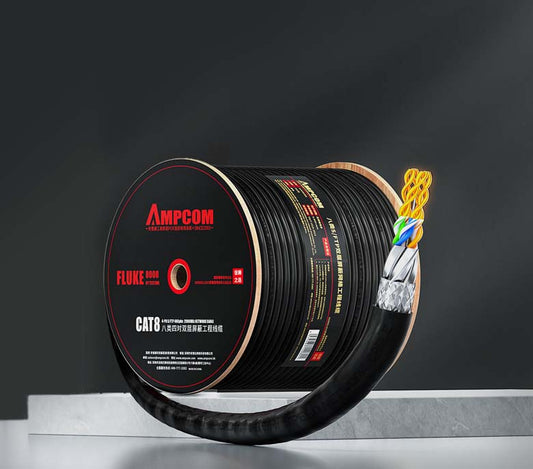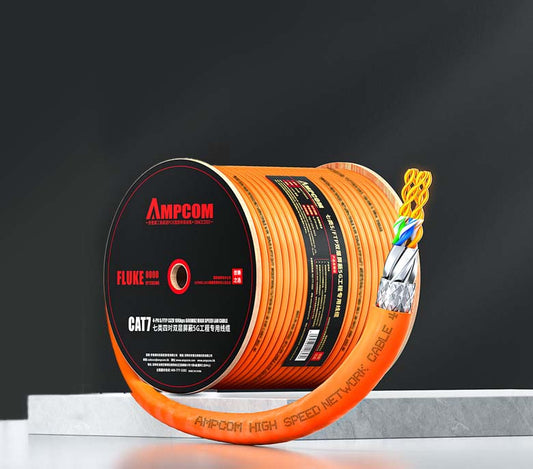مركز البيانات الأسرع من الصوت: كابلات شبكة Cat8 التي تُعرّف الاتصال المباشر بسرعة 40 جيجابت/100 جيجابت في النحاس
مع مواجهة مراكز البيانات للنمو الهائل في البيانات ومتطلبات الحوسبة السحابية، أصبحت الحاجة إلى توصيلات أسرع أمرًا بالغ الأهمية. استجابت كابلات الشبكة من الفئة 8 (Cat8) لهذا النداء، متجاوزةً بذلك حدود أداء النحاس. يُعرّف Cat8 بشكل أساسي بمعيار TIA/EIA-568-C.2-2 (ولاحقًا ISO/IEC 11801-1:2017 Ed. 2.0 Part 1)، وهو مصمم خصيصًا للتطبيقات عالية السرعة وقصيرة المدى، وخاصةً داخل مراكز البيانات. يمهد تنفيذه الطريق لسرعات اتصال 25 جيجابت في الثانية، و40 جيجابت في الثانية، وحتى 100 جيجابت في الثانية عبر النحاس، وإن كان ذلك على مسافات أقصر.
أداء لا مثيل له: كابلات شبكة Cat7 تُنشئ قناة بيانات عالية الدقة من البداية إلى النهاية
اتصال مستقبلي: كابلات شبكة Cat6a تُرسي الأساس لشبكة 10G في كل مكان
أكثر من مجرد توجيه كابلات شبكة الجيجابت: تنفيذ معيار Cat6 الدولي يمهد الطريق لشبكات 10G
فهم إجماع كابلات الشبكة العالمية: معيار Cat5e الدولي يُحدد عصر "الكفاية"

المعايير الرئيسية لمراكز البيانات عالية السرعة وقصيرة المدى
تم تصميم معايير Cat8 لتحقيق الأداء في البيئة الكثيفة لمركز البيانات:
- التردد: يعمل Cat8 بتردد أعلى من Cat7، يصل إلى 2000 ميجاهرتز (2 جيجاهرتز). يُعد هذا التردد المضاعف مقارنةً بـ Cat7 ضروريًا للتعامل مع معدلات البيانات الهائلة.
- السرعة والمسافة: صُمم Cat8 للعمل بسرعة 25 و40 جيجابت في الثانية، عادةً لمسافات تصل إلى 30 مترًا، أو بسرعة 100 جيجابت في الثانية حتى 15 مترًا. هذا المدى الأقصر يُمثل تضحيةً لتحقيق هذه السرعات القصوى عبر النحاس.
- تحسين التحكم في التداخل: للعمل بتردد 2 جيجاهرتز، تفرض معايير Cat8 قيودًا صارمة للغاية على التداخل (NEXT، PSNEXT، ACR-F، PSELFEXT) وفقدان الإشارة. غالبًا ما يتضمن تصميم الكابلات ميزات مثل لفات زوجية أكثر إحكامًا، وفواصل مادية، وهندسة متخصصة لتلبية هذه المتطلبات الصارمة.
- الحماية: مثل كابلات Cat7، تكون كابلات Cat8 محمية بالكامل (عادةً بشاشة شاملة وغالبًا حماية زوجية فردية)، وهو أمر ضروري للتخفيف من التداخل عالي التردد الكامن في بيئات مراكز البيانات الكثيفة.
-
فئات القنوات: يحدد المعيار فئتين للقنوات:
- قناة Cat 8: تدعم 25GBASE-T و40GBASE-T حتى 30 مترًا.
- قناة Cat 8.1 (ترددات تصل إلى 2 جيجاهرتز): تدعم 25GBASE-T و40GBASE-T حتى 30 مترًا، بما يتماشى مع معيار TIA.
- قناة Cat 8.2 (ترددات تصل إلى 2 جيجاهرتز، النوع 40G): مصممة خصيصًا لـ 40GBASE-T حتى 15 مترًا.
- مواصفات الموصل: غالبًا ما توصي معايير Cat8 أو تتطلب موصلات محددة (مثل GG-45 أو TERA) أو موصلات RJ45 محسنة مصممة للحفاظ على أداء القناة عند 2 جيجاهرتز، على الرغم من أن RJ45 يُستخدم أحيانًا مع تحذيرات.
يتضمن تنفيذ هذه المعايير اختبارات صارمة لفقدان الإدخال، وفقدان العودة، وخاصة مكونات التداخل (بما في ذلك Alien Crosstalk، AXR، على مسافة تزيد عن 15 مترًا لفئة Cat 8.2).

سيناريوهات التطبيق: التركيز على مركز البيانات
- الحوسبة عالية الأداء (HPC): ربط عقد الحوسبة في مجموعات مترابطة بإحكام حيث يكون زمن الوصول المنخفض والنطاق الترددي العالي أمرًا بالغ الأهمية.
- البنية التحتية السحابية: ربط مجموعات التخزين ومفاتيح الشبكة والخوادم في بيئات سحابية واسعة النطاق.
- وصلات داخل مركز البيانات قصيرة المدى: حيث يسمح التصميم المادي بمسافات ضمن حدود Cat8 التي تتراوح من 15 إلى 30 مترًا، مما يوفر بديلاً فعالاً من حيث التكلفة للألياف الضوئية لهذه الاتصالات المحددة.

دراسة حالة: مركز البيانات من المستوى الرابع
كانت شركة "كوانتوم داتا سنترز" تُشيّد مركز بيانات جديد عالي الكثافة من المستوى الرابع. كان الهدف هو ضمان أقصى عرض نطاق ترددي بين الخوادم والمفاتيح ضمن الرف نفسه وبين الرفوف المتجاورة، دون الهشاشة والتكلفة المُتوقعة المرتبطة بالألياف الضوئية عالية السرعة لكل اتصال.
اختار فريق البنية التحتية كابلات Cat8، ملتزمين بمعيار TIA Cat 8.1 لوصلات 25 جيجابت في الثانية، ومعيار Cat 8.2 لوصلات 40 جيجابت في الثانية عند الحاجة. ركّبوا كابلات Cat8 محمية بموصلات RJ45 مُحسّنة، مما يضمن تأريضًا وتوصيلًا سليمين وفقًا لمواصفات المعيار. مكّنهم ذلك من ملء رفوف مركز البيانات بكثافة بالخوادم والمفاتيح، محققين اتصالًا بسرعة 25 أو 40 جيجابت في الثانية على امتداد 30 مترًا داخل ممرات مركز البيانات.
كانت النتيجة شبكة نحاسية أساسية عالية الأداء واقتصادية لمعظم اتصالاتهم الداخلية، مما قلل بشكل كبير من الاعتماد على الألياف الضوئية في هذه المسافات القصيرة. وفّر تطبيق معيار Cat8 الموثوقية والأداء اللازمين لدعم أعباء العمل الشاقة، مما أثبت فعاليته في أكثر البيئات التي تتطلب أداءً عاليًا.
تُمثل كابلات الشبكة Cat8، بفضل تطبيقها الدقيق لمعاييرها الدولية، قمة أداء كابلات النحاس. ورغم أن قصر مداها يحد من نطاق استخدامها، إلا أنها تُقدم حلاً قويًا واقتصاديًا لتلبية متطلبات السرعة العالية وقصر المد في مراكز البيانات الحديثة، حيث تُمكّن نقل البيانات بسرعة فائقة.



